How to Increase Your Conversion Rates with Lead Nurturing
Before to know what is the definition of lead nurturing, we need to see the relationship between business and consumers has changed somewhat over the past few years.
Previously, buyers would come to a business looking for a solution. They might have some idea of what they want but ultimately, they’d need help in guiding their decision.
This dynamic allowed brands to dominate the conversation.
However, the shoe is now on the other foot, so to speak.
Consumers conduct their own research on the internet. They evaluate their options, visiting perhaps a dozen different sites before thinking about engaging with a brand.
In fact, the majority of users who enter your website will never buy a thing from you.
To give you an idea, the average visit-to-sale conversion rate for an eCommerce site is around 3-4%. That means that 96-97% of visitors to a website are not ready to buy.
So if you try to hit them over the head with your product as soon as they land on your homepage, then they’re going to leave.
This is where patience and a bit of lead nurturing come into play.
What is the Definition of Lead Nurturing?
Lead nurturing is the steady delivery of valuable content to potential customers through your digital content strategy - typically via email - as they progress through the buyer’s journey.
The primary goal is to build a lasting relationship with customers, to the point they have complete trust in your brand. This is done by proving your expertise in a given area.
Then, and only then, will they be willing to purchase from you.
As soon as they feel you no longer have their best interests at heart (or you seem determined to bring down the hammer prematurely on a sale) they’ll leave.
Why is Lead Nurturing Important?
As we mentioned before, customers generally aren’t ready to purchase after their first interaction with your brand.
While sales cycles vary between industries, research found that 63% of people making inquiries into a company take up to three months before making a purchase.
What’s more, A further 20% won’t purchase for 12 months. This just goes to show how important the steady nurturing of leads is.
It helps brands develop those all-important relationships with customers so that when they are ready to purchase, they’re top of mind.
How to Launch a Lead Nurturing Campaign
Now that you understand what a lead nurturing campaign is, and why it’s so essential to your marketing strategy, let’s take a look at how to launch one.
Typically, a lead nurturing campaign goes through the following 5 steps:
Segmenting your database
Aligning content with your buyer’s journey
Setting up a lead scoring system
Decide on an automation tool
Track, measure, improve
Segmenting your Database
The best lead nurturing campaigns deliver high-quality content to leads based on their position in the customer journey.
Why?
Because content that’s relevant to someone who’s just discovered your brand (and is still figuring out what it is you do) probably isn’t for a lead who’s almost ready to purchase.
The goals and CTAs are completely different.
By in large, you’re going to want to segment your database into the following 3 categories:
Awareness - Top of the Funnel (TOFU): Someone at the very beginning of the buyer’s journey. These people are of who you are and have a vague idea of your products and services. However, they are by no means ready to purchase.
Consideration - Middle of the Funnel (MOFU): Leads pass to this phase of the buyer’s journey after displaying some buyer intent, or at the very least, heavily engaged with the brand. At some stage in the future, they could be a potential sales qualified lead (SQL).
Decision - Bottom of the Funnel (BOFU): Leads arrive here after indicating they’re fairly close to a purchase decision.
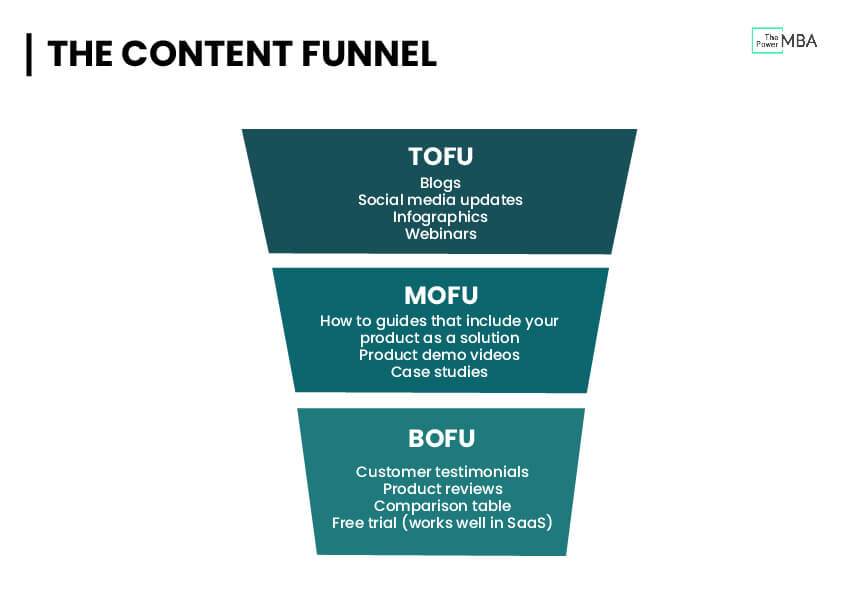
While segmenting leads by their corresponding position in the customer journey (needs-based segmentation) is a great starting point, you can go a step further if you want to offer an even more personalized customer experience.
Further segmentation can be done by:
Geography (county, state, city, country, etc.)
Value (economic potential to your company)
Behavioural (tendencies, product use, etc.)
Demographic (age, gender, marital status, etc.)
If you’re a little unsure of how to segment your database, then I recommend looking at lead scoring - something will investigate at stage #3.
Align Content to the Buyer’s Journey
The next stage of the lead nurturing campaign is content alignment.
As we just touched upon, a lead’s position in the buyer journey determines what type of content they should receive.
Even if a lead enters through the same channel, it doesn’t necessarily indicate they have the same needs, interests, or urgency to buy.
That’s why treating all leads equally is a mistake.
To ensure you’re offering consistent value you need to deliver certain content formats, to the right person, at the right time.
Let’s take a more detailed look at our buyer’s journey:
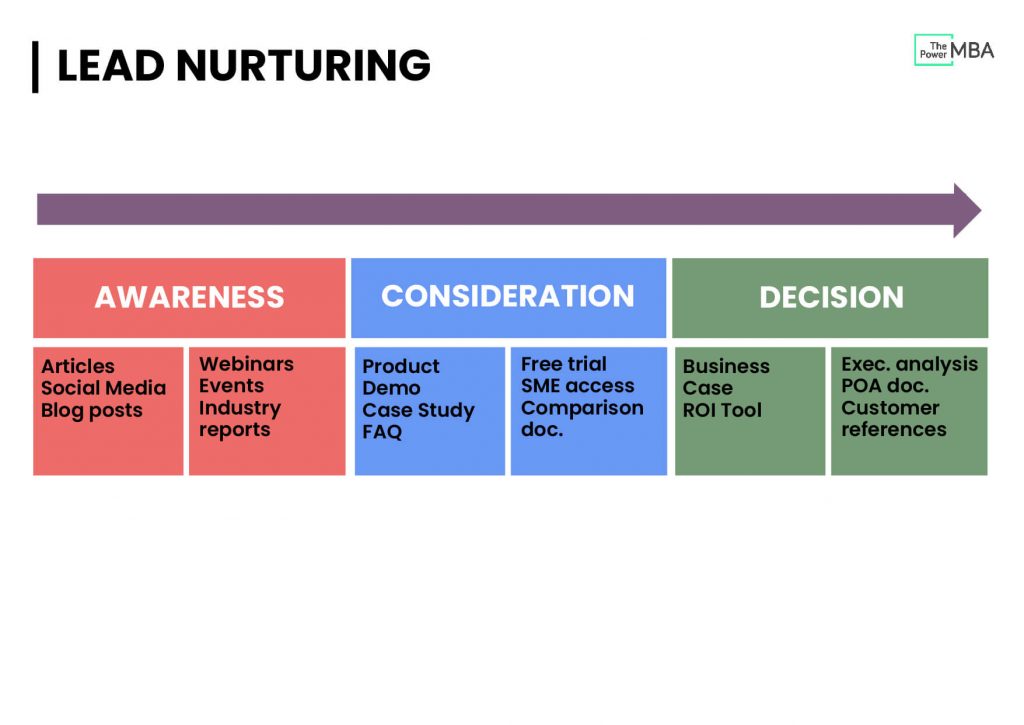
Based on SiriusDecision’s Buyer Mapping Journey we still have the three core pillars: awareness, consideration, and decision.
However, as you’ll notice there are six additional sub-sections - two for each pillar:
Loosen Status Quo
Commit to Change
Explore Solutions
Commit to a Solution
Justification
Selection
This allows us to get more granular with our content delivery.
Loosen Status Quo
Leads at the very start of the funnel are aware they have a problem. It’s up to you to show them how to address it.
They’ll be asking themselves, is this an issue that needs addressing immediately? Is it something faced industry-wide?
Think about content attracts a lead’s attention and triggers this realization:
Blog posts
Social media posts
News articles
Commit to Change
Leads now understand they need to take action.
They’ll be asking themselves, what are the consequences of inaction? Will it negatively impact our competitiveness? Is this a true industry shift or just a trend?
Here you need to deliver content that highlights an opportunity, and/or creates a sense of urgency to take action:
Webinars
Events
Industry analysis reports
Explore Solutions
An internal decision has now been made that something needs to be done.
Common questions here are, how will an alternative solution improve our position? Will it require a change in technology or methodology?
It’s time to think of content that shows how you remedy this situation:
Case studies
FAQ doc
1-on-1 product demo
Commit to a Solution
Leads at this stage are leaning more towards your brand as a solution to their needs.
They’re now looking to see if you have the technical prowess to meet their demands? Is their proof? Do the benefits outweigh the risks in this new investment?
Some content ideas include:
Free trial
Competitor comparison doc.
SME (subject matter expert) proof
Justification
Leads now need to be able to justify their decision to stakeholders.
They’ll be wanting to know why this is the right investment, right now. Will early adoption provide an immediate competitive advantage?
Some content ideas include:
Detailed business cases
ROI (return on investment) tools
Selection
In the final stage of the buyer’s journey leads are ready to move forward with your solution.
A few lingering questions will need to be answered, such as how will you help mitigate any disruption involved during implementation? How will you help support their POA (plan of action?
Ideally, you would deliver:
Detailed executive analysis
POA documentation
Customer reference (if available)
Lead Scoring
When you begin to see a high volume of leads enter the funnel (or are looking to segment an already existing database) you have to start ranking them by interest.
This will help you to:
Prioritize resources and optimize efforts by focusing on the leads that are most likely to buy from you.
Ensure leads are receiving content aligned with their position in the funnel.
Take concrete action according to the quality of that lead.
How Are Leads Evaluated?
When assigning leads a score two factors have to be taken into account:
Lead Interest
Lead Fit
Lead interest is about gauging someone’s interest in your product. This is done by tracking their online behavior and how they interact with your content.
It helps you identify leads at the early stage of the funnel (consuming primarily educational content) from those actively considering a purchase (signing up for a product demo).
Each behavioral interaction is assigned a score based on buyer intent.
The more serious the intent, the higher the score.
Take a look at the following example
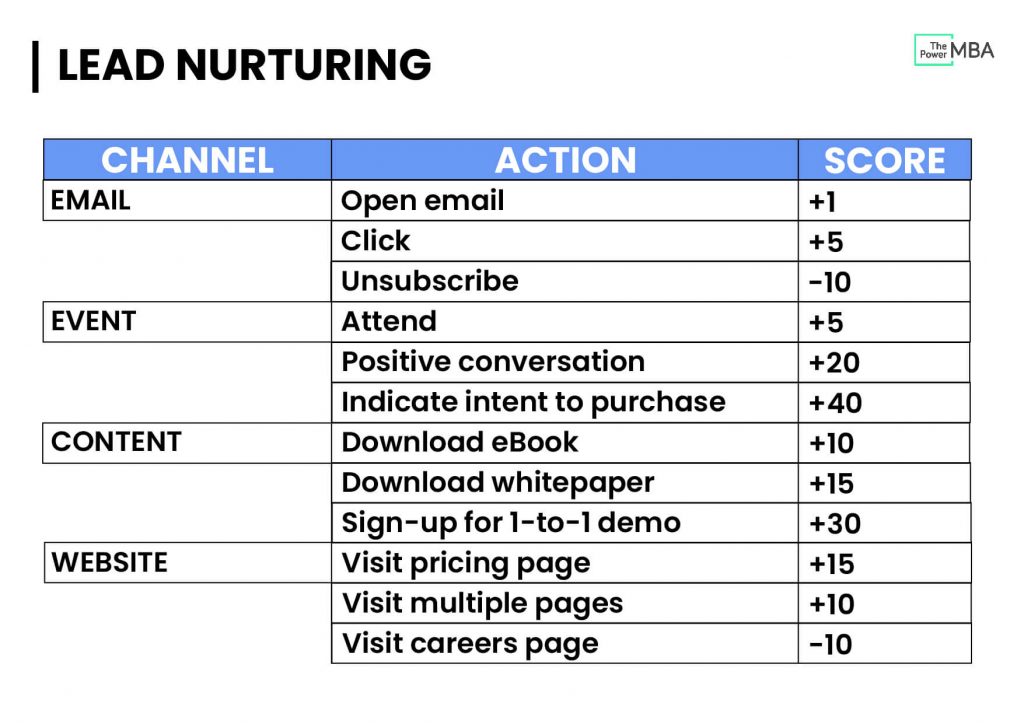
On the other hand, lead fit is about looking at a person’s characteristics. This could include information such as:
Company size
Location
Annual revenue
Job position
Industry
Typically, this information is gathered on a customized lead generation form.
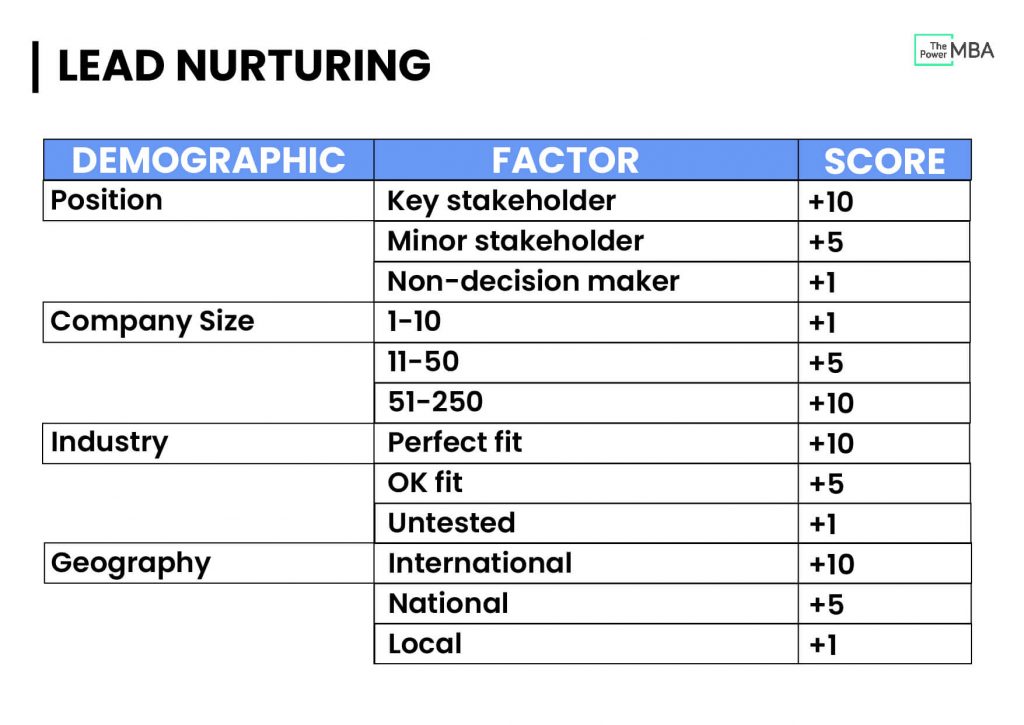
Try thinking of it as a video game. To move to the next level (stage of the buyer’s journey) you need to accumulate enough points.
These points are earned by interacting with different content marketing actions. If you dedicate enough time to the game you’ll eventually complete the final level…
...and purchase!
Lead Nurturing Automation With Marketing Tools
When managing a small database you might find manual interaction is preferable from lead to lead.
However, as soon as you start ramping up it’s essential to automate as much of the process as possible.
It will save you a lot of time and effort in the long run.
Now, there is an abundance of marketing automation software available. Some of the most popular are:
Marketo
Hubspot
Mailchimp
Sendy
Nimble
Eloqua
It’s important you cross-check each tool against your needs. You’ll find some providers are stronger in certain areas than others, meaning it’s often down to personal preference.
You might want to consider some of the following questions when filtering through providers:
Does it allow you to score leads based on criteria aligned to your business?
What does the user interface look like? Is it intuitive, and easy to use?
Can leads be nurtured through various channels (online, offline, social media, events, email, etc.)
Are there any limitations to segmentation?
Can leads be easily assigned to the correct drip campaign?
Are sales representatives able to view a lead’s entire lifecycle in the CRM?
Whichever system you choose, it’s going to help you provide a more personalized experience for your customers.
Let’s take a look at a typical drip campaign set up in a marketing automation tool:
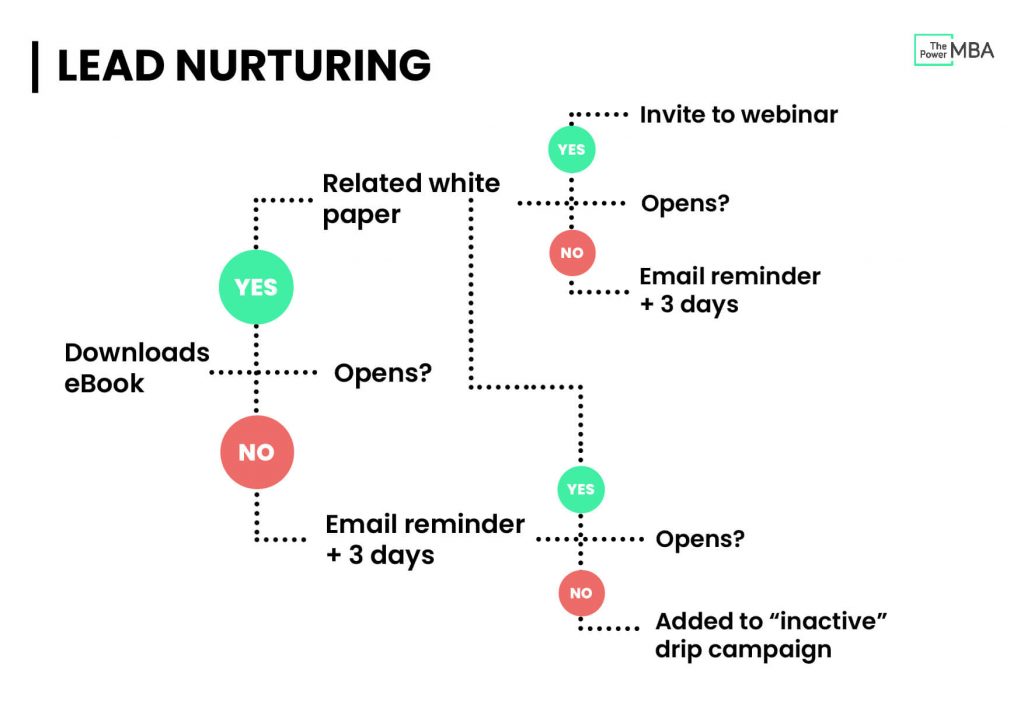
As you can see, each action (or inaction) automatically triggers a response. The more actions a lead takes through the campaign, the more points they accumulate.
Eventually, leads will have interacted enough with your brand to warrant a call from a member of your sales team.
One thing to remember when creating drip campaigns is to ensure leads are not entered into several at a time.
It creates a disjointed experience as they receive conflicting messages and content that doesn’t correlate with their position in the buyer’s journey.
Think of it this way.
Imagine you just met a friend for coffee in the center of town. You’ve spent an hour catching up, gossiping, and discussing the weather.
You both have to return to work, so say your goodbyes, and agree to meet next week.
Five minutes later you receive a phone call from the friend you just met…
“Hey, it’s been too long without seeing you, we must catch up sometime! Are you free tomorrow?”
Eh? But, we just met?
The same thing happens with your leads. When they’re contacted by different people, with different messages, at the wrong stage of the buyer’s journey...it can be very confusing!
Measuring Your Lead Nurturing Campaign
The final stage of the lead nurturing campaign is about measuring, testing, and ultimately improving performance.
As they say…
“What can’t be measured, can’t be improved”
However, it’s important not to test for “testing’s sake”. Ensure you are measuring data closely tied to desired goals and outcomes.
So what are some of the common email metrics we can analyze and improve?
Open rate
Click-to-open rate (CTO)
Unsubscribe rate
Marked as spam
List growth rate
Forwarding rate
Tactics For Improving Campaign Performance
If you are struggling with low open rates, high unsubscribe rates, and often finding your mails marked as spam, it’s best to start analyzing your subject lines.
It shouldn’t take up too much time brainstorming a few alternatives. Once you’ve come up with 4-5 alternatives, it’s time to A/B test them on a small control group.
I recommend you set the duration of the test between 3-4 days. This should allow for any changes in performance to be logged.
It’s important to only change one variable at a time. This way cause and effect can be determined.
The variables with the biggest impact and increase in performance should then be incorporated into your lead nurturing campaign.
Some other factors you could consider changing are:
Content/content length
Content offer
Frequency
Email design
However, as we mentioned earlier, each factor needs to be aligned to a corresponding metric, which reports to a specific business goal.
Why Should I Invest in Lead Nurturing?
When you commit to a lead nurturing campaign, you’re investing in one of the most cost-effective demand generation strategies available to marketers.
The content delivered speaks to potential customers on a personal level, addresses their specific concerns, and can be easily scaled.
What’s more, nurturing helps build and maintain long-term relationships with customers and generates higher-quality leads for your sales team.
So if you haven’t already, give it a try!






